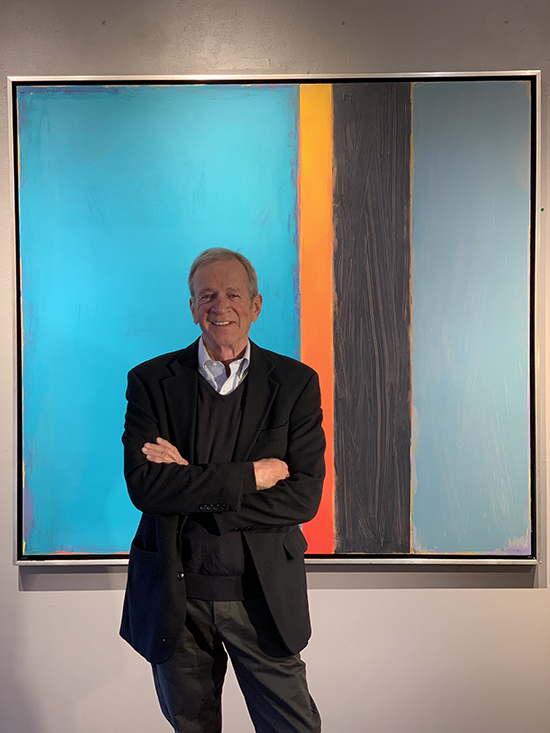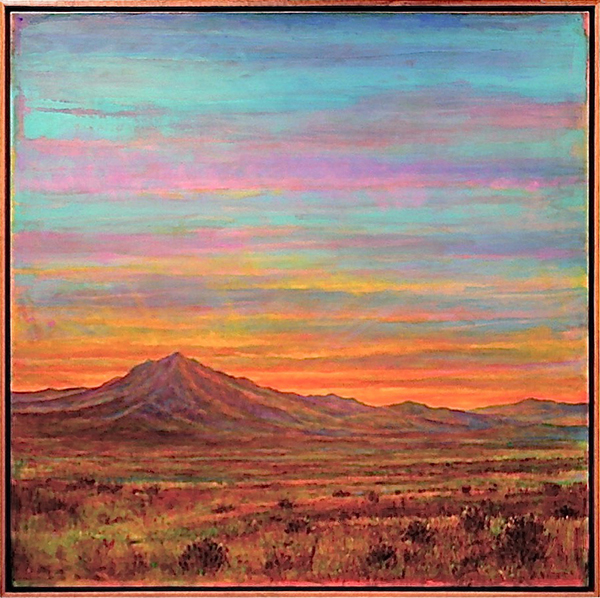Writer Shannon Severson
Photography Courtesy of Grace Renee Gallery
[dropcap]S[/dropcap]tanding before a piece of David Rothermel’s art is to view not just layers of color and texture, but also a process and vision honed by 45 years of inspiration and introspection—and maybe a touch of divine connection.
“I want [people] to bask in the glory of the color and get that quiet feeling,” Rothermel says. “When you look at high art, you don’t know exactly what you’re looking at, but your sensory perceptions are kicking in. Something is going on. It vibrates. They see there’s a lot more work in each piece than what might appear at first glance.”
The Santa Fe-based painter, whose abstract works are on display at Carefree’s Grace Renee Gallery, takes color field style to a new level with his technique of layering acrylic paint in full- and halftones on panels of wood in varying widths.
This style is a reflection of his early days as a billboard painter, at which time he first had the idea of painting individual panels to be experimented with and assembled later instead of confining himself to a single surface.
“When the paint is wet and they’re nice and shiny and gooey, it’s a thrill,” he says. “Because I use acrylics, they dry to a middle value. The dark colors dry a little lighter and the lights dry a little darker. The color intensity is slightly muted and that is evident in the work I have hanging at Grace Renee Gallery.”
When the paint dries, Rothermel uses a hand-sander and water to create depth and luminosity by stripping away layers. This process reveals the colors and the texture of the wood panel beneath and leaves a record of the under-color on the edges.
The painter is coaxing life out of something two-dimensional. The debris is wiped away and what Rothermel describes as “spatial continuity turned into the sublime” comes through, creating a “portal” for the beholder.
Some of the arrangements come by chance and many come from intuitive experience, trusting in the process that it will all turn out. There is a lot of flexibility built into his materials and methods. He can assemble and reassemble until the combination feels right.
“When you over-paint and under-paint the panels, that’s when they come alive and you get the color field,” he says. “You have to work it until it works you.”
Rothermel considers his larger pieces to be some of his most successful.
“You’re ‘in’ the painting,” he explains. “You’re in the atmosphere. You notice the edges of colors that you didn’t see at first. The juxtaposition between one panel and the next is really important.”
Rothermel’s approach takes the traditional building blocks of color and technique, the eternal truths of Fibonacci code, ratios and the golden means, and imbues them with the “breath and breadth of abstraction.” It is a spiritual exercise for him.
Art has always been something that he has been compelled to do.
Rothermel first picked up a paintbrush to help his mother—a teacher—paint the plank floors of her one-room schoolhouse’s porch in Pennsylvania. He always had a love of the outdoors and would create pen-and-ink sketches of the scenes he saw while playing or hunting small game.
The painter recalls being influenced by everything from the Paul Cézanne paintings in his elementary classroom to TV westerns like Zorro and Bonanza, which captured his young imagination.
“I always had cowboy boots and a Western hat on,” Rothermel says. “It was always right there on the tip of my conscience that I wanted to go west one day. I’m still a cowboy—just a little older and a little wiser.”
He began studying commercial art at York Academy of Art. After a field trip to New York City’s Metropolitan Museum of Art—where he discovered and was completely inspired by artist Hans Hofmann—and at the urging of an influential instructor, he decided to pursue fine art at Pennsylvania Academy of Fine Art.
Rothermel also spent a summer in Maine at Skowhegan, studying with well-known artists like Josef Albers and the prolific abstractionist Brice Marden, while learning, absorbing and fine-tuning his own abstractionist style.
“I came out of art school painting non-objectively, very abstract pieces,” he says. “I tried to move to New York four times and it spit me out.”
Rothermel has been sober for 30 years now but admits to partying during his youth.
“It was hell with the lid off,” he explains. “I’d rather buy a six-pack than pay my electric bill. I didn’t have the maturity.”
In the back of his head, Rothermel knew that being in the studio was the thing that was going to get him ahead—not the other way around.
“You have to think with your eyes,” the painter says. “When you’re in the studio, it’s a quiet process where you do one thing and another thing happens and then something else is revealed, so you try and hit on those special parts.”
It was time to fulfill his dream of heading west. Rothermel moved to New Mexico in 1981. He was ready to paint whatever he saw and felt free to experiment without judgment. He painted landscapes and sunsets with oils, watercolors and acrylics.
Painting billboards paid the bills until a strong gust of wind knocked him from his ladder and he broke both of his arms.
“The accident was a godsend,” he says. “It prompted me to really pursue my art. I had to go out on my own and get back to the source. I quit my job, got a divorce and moved to Santa Fe in 1987. That’s when the market was hopping and everyone was moving here. It was great energy.”
His Santa Fe gallery has been open for many years and Rothermel has mostly concentrated on creating and displaying his abstract work.
As time and technology have changed the world and the way people consume art, Rothermel ponders how art—true, transcendent art––shapes our experiences as humans as well as the legacy of his own art. He believes that the human connection to the spiritual realm is strengthened by principles that exist outside of the immediate.
“The eternal rules are what make things work,” he explains. “I want to reveal the sublime. If it doesn’t reveal the sublime, it’s not art because it won’t do anything.”
The Abstract Art of David Rothermel
Thursday, Feb. 20 | 4–7 p.m. | Grace Renee Gallery | Historic Spanish Village | 7212 E. Ho Hum Road, Carefree | 480-575-8080









Comments by Admin